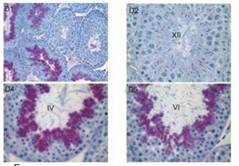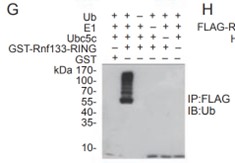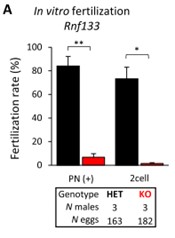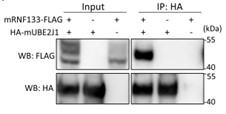RNF133
-
Official Full Name
ring finger protein 133 -
Overview
The protein encoded by this gene contains a RING finger domain, a motif present in a variety of functionally distinct proteins and known to be involved in protein-protein and protein-DNA interactions. This gene has no intron. -
Synonyms
RNF133;ring finger protein 133;E3 ubiquitin-protein ligase RNF133;E3 ubiquitin protein ligase RNF133;MGC27072;RNF 133;OTTHUMP00000211453
Recombinant Proteins
- Human
- Mouse
- Rat
- Mus musculus
- Macaca fascicularis
- E.coli
- Mammalian Cells
- HEK293
- His
- Non
- Avi
- Fc
Background
What is RNF133 protein?
RNF133 gene (Ring Finger Protein 133) is a protein coding gene which situated on the long arm of chromosome 7 at locus 7q31. RNF133 is a testis-specific E3 ubiquitin ligase that plays a crucial role in male fertility. It is highly conserved across mammals and contains a C3H2C3 RING finger domain, which is characteristic of this class of proteins involved in ubiquitination, a process that tags proteins for degradation or involved in other cellular processes. The RNF133 protein is consisted of 376 amino acids and RNF133 molecular weight is approximately 42.3 kDa.
What is the function of RNF133 protein?
RNF133 is predominantly expressed in the testis and has been found to be particularly important during spermatogenesis, the process of sperm cell development. Studies have shown that RNF133 interacts with UBE2J1, an ER-localized E2 enzyme also highly expressed in the testis, and is involved in the ubiquitination pathway to degrade and discard unnecessary proteins from the endoplasmic reticulum (ER). In mouse models, the loss of RNF133 has been associated with severe subfertility due to defects in sperm motility and fertilization, indicating its essential role in sperm function during spermiogenesis.
RNF133 Related Signaling Pathway
As an E3 ubiquitin ligase, RNF133 is likely involved in the ubiquitin-proteasome pathway, which is responsible for tagging proteins for degradation by the proteasome. RNF133 is highly expressed during spermatogenesis, suggesting it is involved in the signaling pathways that regulate the development and maturation of sperm cells. Some RING finger proteins are implicated in the regulation of the innate immune response. Although RNF133's specific role in immunity is not clear, it may have related functions, particularly given its tissue-specific expression in cells that have immune-related roles. As an E3 ligase, RNF133 likely contributes to maintaining protein homeostasis by regulating the stability and turnover of target proteins within testicular cells.
RNF133 Related Diseases
RNF133 is an E3 ubiquitin ligase that is mainly expressed in the testes and is closely associated with sperm development and maturation. Mutations or abnormalities in the function of RNF133 may be associated with male infertility, as they may affect the normal formation and function of sperm. In addition, RNF133 has been associated with certain neurological disorders, particularly Developmental and Epileptic Encephalopathy 73. Although RNF133 is specifically expressed in the testes, its role in the nervous system and its link to related diseases require further research to clarify.
Bioapplications of RNF133
As a key regulator of spermatogenesis, the study of RNF133 contributes to the in-depth understanding of the male reproductive mechanism and provides a new perspective for the study of reproductive health. Understanding the function of RNF133 and its role in sperm formation could help develop new treatments for specific male infertility. RNF133 could be a target for drug screening to develop drugs that affect spermatogenesis, which could have important implications for treating certain types of infertility or developing non-hormonal contraceptives. The role of RNF133 in germ cell differentiation may have potential applications for the use of stem cell technology to study and treat germ cell-related diseases.
Case Study
Case Study 1: Hong Nian, 2008
Spermatogenesis, the process by which sperms are generated within the male gonads, involves a number of events that occur only in the testis. To support the accomplishment of these events, it is hypothesized that a large number of testis-specific genes need to be expressed. Identification of these genes and their biological functions will not only help us to elucidate the mechanisms of spermatogenesis but also provide potential targets for novel non-hormonal contraceptive drugs. In this study, RNF133 belongs to the RING finger protein (RNF) family, whose members are very divergent in terms of their sequences and functions except for sharing a RING domain. A number of RNFs have been reported to be expressed in the testis, but their functions are poorly understood. Multiple sequence alignment of Rnf133 proteins from five mammalian species indicated that they are highly conserved. All these proteins possess a C3H2C3 RING finger domain, a protease-associated (PA) domain, a signal peptide (SP) and a transmembrane (TM) domain. These features are typical of the GREUL (for Goliath Related E3 Ubiquitin Ligase) proteins, a group of RNFs with some of its members being identified as E3 ubiquitin ligases.

Fig1. Immunohistochemical localization of Rnf133 protein in the adult mouse testis.

Fig2. Self-ubiquitination of recombinant GST-Rnf133-RING protein in an in vitro ubiquitination assay.
Case Study 2: Kaori Nozawa, 2022
Ubiquitination is a post-translational modification required for a number of physiological functions regulating protein homeostasis, such as protein degradation. The ER transmembrane protein UBE2J1 is a E2 ubiquitin-conjugating enzyme reported to be essential for spermiogenesis at the elongating spermatid stage. However, associated E3 ubiquitin-protein ligases that function during spermatogenesis remain unknown. Researchers identified four evolutionarily conserved testis-specific E3 ubiquitin-protein ligases including RNF133. Using the CRISPR/Cas9 system, they generated and analyzed the fertility of mutant mice with null alleles for each of these E3-encoding genes, as well as double and triple knockout (KO) mice. Ultrastructural analysis demonstrated that cytoplasmic droplets were retained in Rnf133 KO spermatozoa. Although Rnf133 and Rnf148 encode paralogous genes that are chromosomally linked and encode putative ER transmembrane E3 ubiquitin-protein ligases based on their protein structures, there was limited functional redundancy of these proteins. In addition, researchers identified UBE2J1 as an E2 ubiquitin-conjugating protein that interacts with RNF133.

Fig3. Quantification of pronucleus-positive or two-cell embryos.

Fig4. Western blot analysis of immunoprecipitation.
Involved Pathway
RNF133 involved in several pathways and played different roles in them. We selected most pathways RNF133 participated on our site, such as , which may be useful for your reference. Also, other proteins which involved in the same pathway with RNF133 were listed below. Creative BioMart supplied nearly all the proteins listed, you can search them on our site.
| Pathway Name | Pathway Related Protein |
|---|
Protein Function
RNF133 has several biochemical functions, for example, ligase activity,zinc ion binding. Some of the functions are cooperated with other proteins, some of the functions could acted by RNF133 itself. We selected most functions RNF133 had, and list some proteins which have the same functions with RNF133. You can find most of the proteins on our site.
| Function | Related Protein |
|---|---|
| ligase activity | LIPT2,RNF144AA,UBE2NB,WWP1,UBE2L3B,UBE2D1B,SH3RF1,TRIM5,UBE2KA,BTRC |
| zinc ion binding | PAPLNB,DTNBA,PHC2B,TRIM35-30,MORC2B,TLL2,AGBL3,HDAC6,TRIM35-28,GATAD1 |
Interacting Protein
RNF133 has direct interactions with proteins and molecules. Those interactions were detected by several methods such as yeast two hybrid, co-IP, pull-down and so on. We selected proteins and molecules interacted with RNF133 here. Most of them are supplied by our site. Hope this information will be useful for your research of RNF133.
UBE2H;UBE2I
Resources
Related Services
Related Products
References


